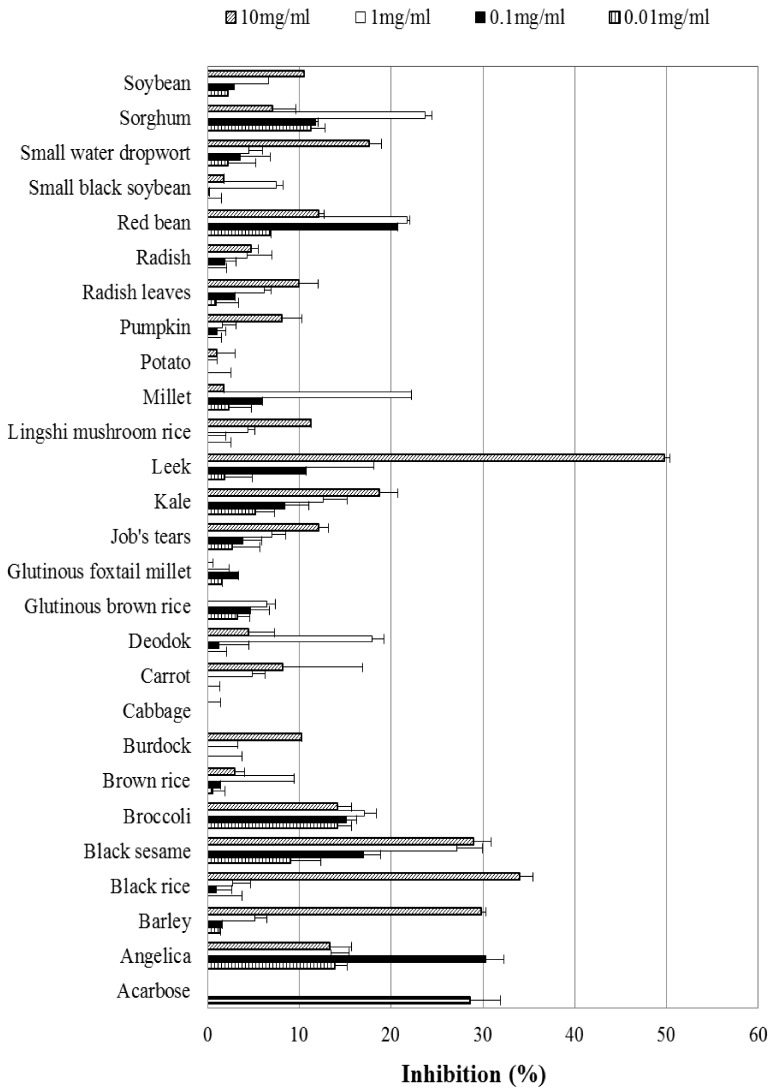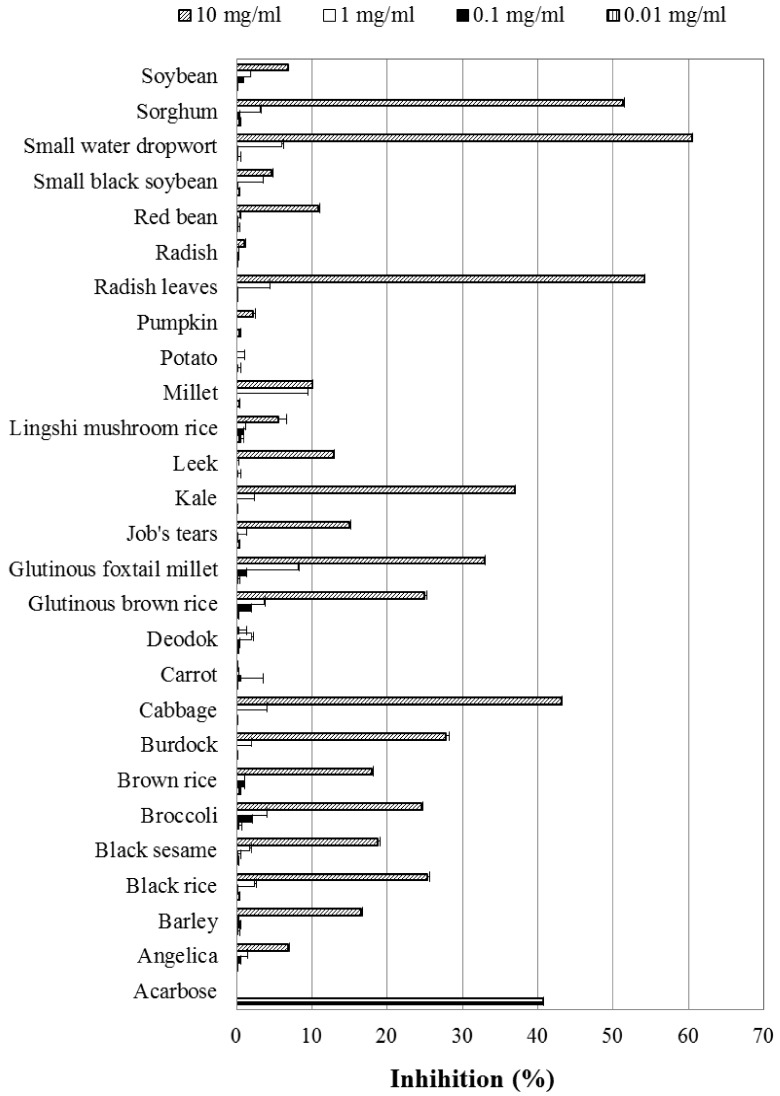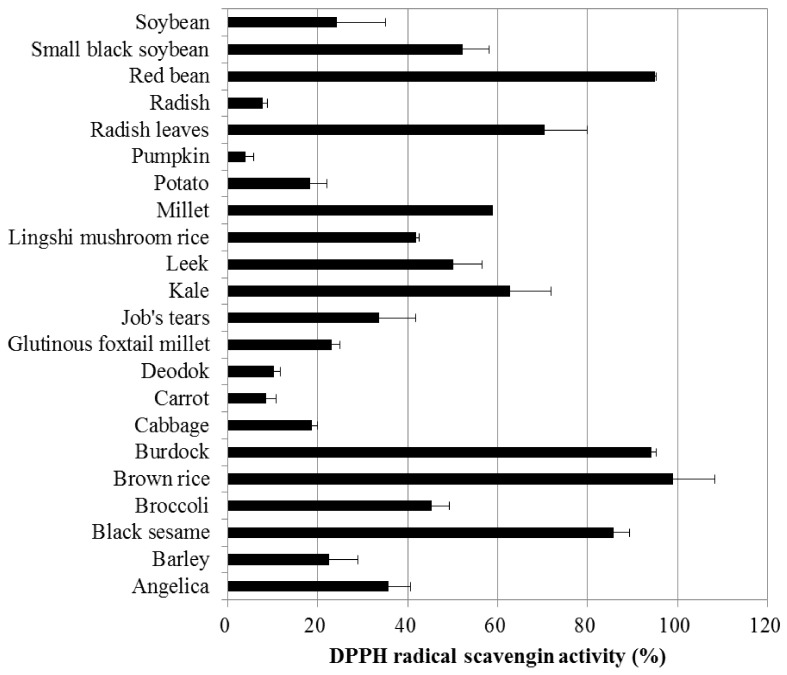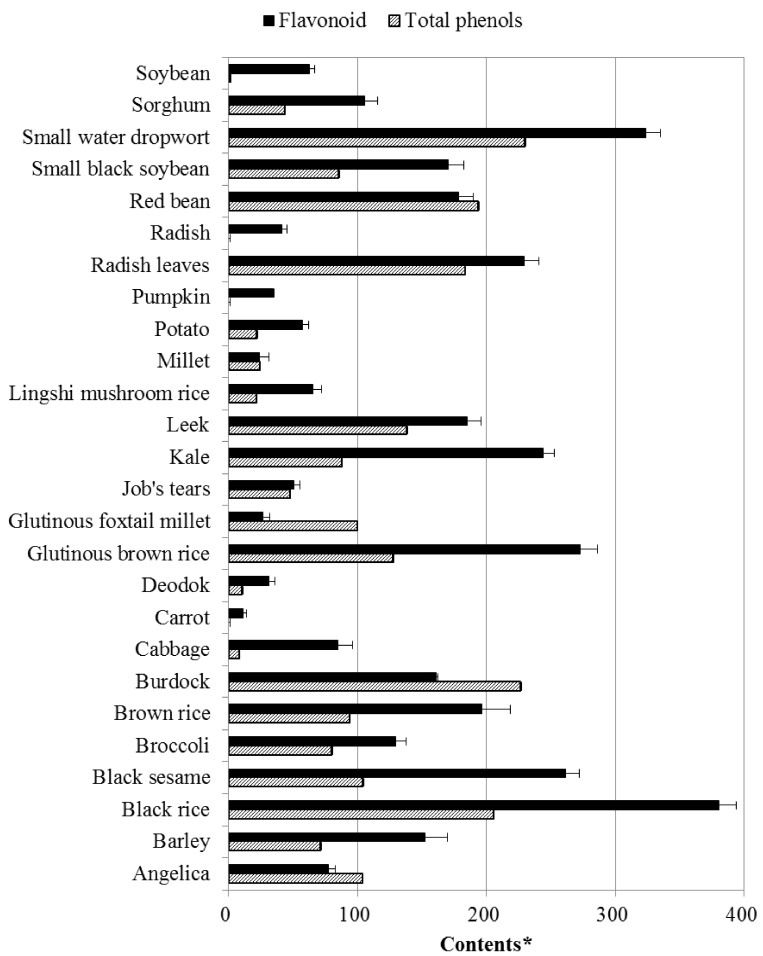Abstract
BACKGROUND/OBJECTIVES
We investigated total 26 ingredients of Saengshik which will be commercially produced as an anti-diabetic dietary supplement.
SUBJECTS/METHODS
Thirteen vegetables, nine cereals, three legumes and one seed were extracted with aqueous ethanol for 2 h at 60℃, and evaluated for their inhibitory effects against α-amylase and α-glucosidase and for total phenolic and flavonoid contents.
RESULTS
All ingredients inhibited α-amylase activity except cabbage. Strong inhibitory activity of α-amylase was observed in leek, black rice, angelica and barley compared with acarbose as a positive control. Stronger inhibition of α-glucosidase activity was found in small water dropwort, radish leaves, sorghum and cabbage than acarbose. All Saengshik ingredients suppressed α-glucosidase activity in the range of 0.3-60.5%. Most ingredients contained total phenols which were in the range of 1.2-229.4 mg gallic acid equivalent/g dried extract. But, total phenolic contents were not observed in carrot, pumpkin and radish. All ingredients contained flavonoid in the range of 11.6-380.7 mg catechin equivalent/g dried extract.
CONCLUSIONS
Our results demonstrate that Saengshik containing these ingredients would be an effective dietary supplement for diabetes.
Keywords: Saengshik, α-amylase inhibition, α-glucosidase inhibition, total phenolic compounds, antioxidant activity
INTRODUCTION
Diabetes mellitus is a major endocrine disorder and chronic metabolic disease characterized by hyperglycemia. Type 1 diabetes is caused by the failed production of insulin by pancreatic islets of Langerhans, and type 2 diabetes is resulted from insulin resistance combined with inadequate insulin secretion [1]. Diabetes can lead to a number of cardiovascular and neurological complications. Globally, about 90% of diabetes patients have type 2 diabetes which can be prevented or recovered with appropriate diet [2]. The most effective diet or therapeutic approach to prevent and treat diabetes and its complications has been considered to decrease the postprandial hyperglycemia by delaying the absorption of glucose in the small intestine. This is often done by the inhibition of α-glucosidase and α-amylase which are pivotal enzymes to hydrolyze carbohydrate. Such inhibitory effect can retard the digestion and absorption of carbohydrate and result in the suppression of post-prandial hyperglycemia [3]. According to Korean Food Standards Codex [4], Saengshik is "uncooked foods, referring to powder, granule, bar, paste, gel, liquid, or other forms of food made of animal or plant derived materials, usually processed by drying, to be used as it is or after mixing with water or others". Non-heat processing allows Saengshik to preserve digestive enzymes and heat labile nutrients such as vitamins, minerals and phytochemicals [5]. Thus, Saengshik has been consumed as a functional food for human health as well as a substitute for meal. Kim et al. [6] reported that Saengshik possessed the antioxidant defense system property by scavenging oxidants in an in vivo animal model and by stimulating total antioxidant activity in human. Also, Saengshik has been found to have beneficial effects on weight loss with decreased total- and LDL-cholesterol levels [7, 8] and on alleviated fatty liver damage [9]. Our previous study proved a positive effect of Saengshik on blood glucose concentrations in diabetic rats, which prolonged their survival [10]. However, there are still few studies on the anti-diabetic effects of Saengshik. Therefore, this study aimed to evaluate the inhibitory activity of twenty six ingredients in Saengshik against α-amylase and α-glucosidase.
MATERIALS AND METHODS
Materials
Total 26 Saengshik ingredients were obtained from Erom Co., Ltd (Seongnam-si, Gyeonggi-do, Korea; Table 1). Each of the Saengshik ingredients was extracted with 80% ethanol for 2 h at 60℃, centrifuged at 3,800 × g for 10 min, evaporated at 60℃, and freeze-dried.
Table 1.
Ingredients of Saengshik
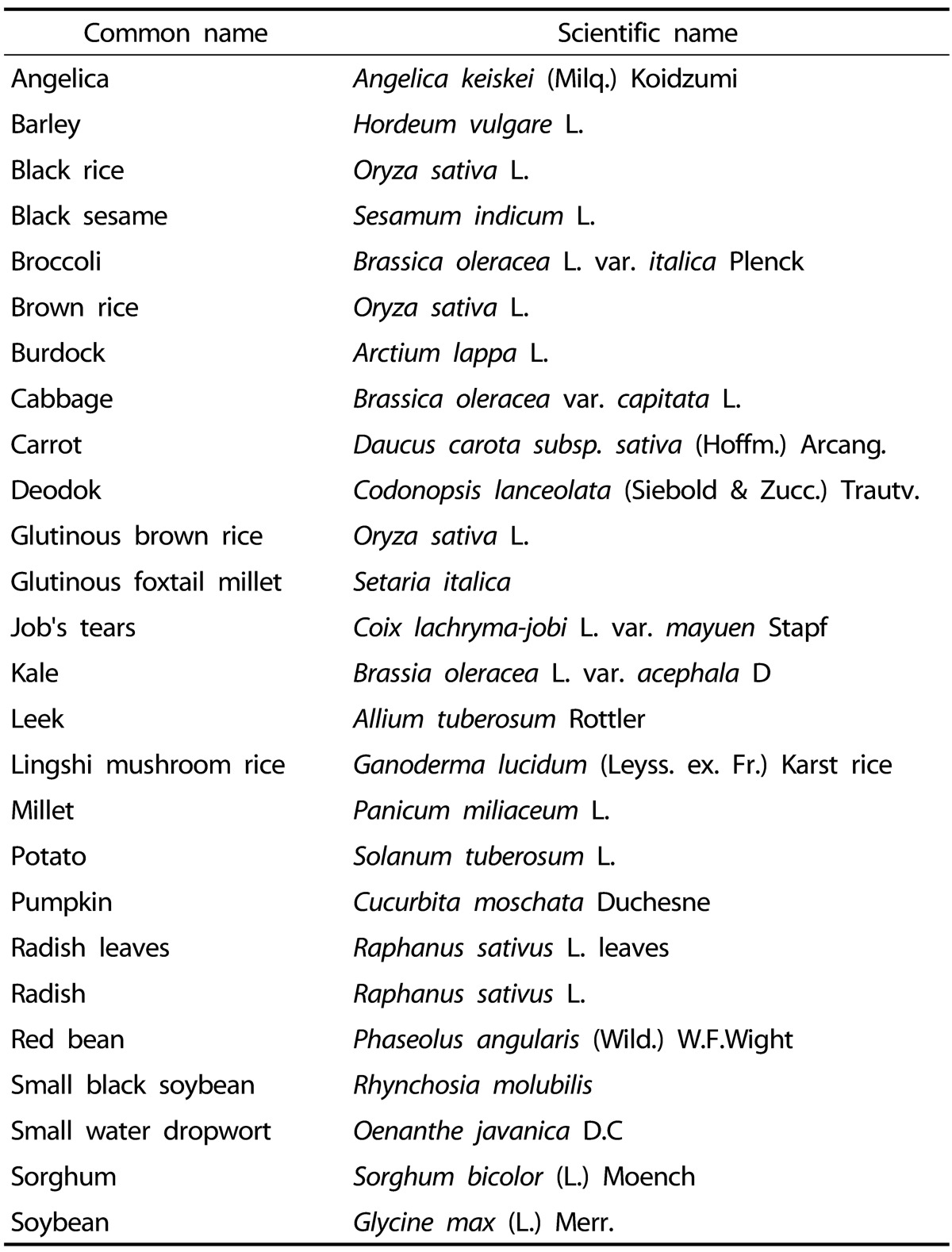
α-Amylase inhibitory activity
Ten microliter of α-amylase solution (1 mg/ml) from human saliva (Sigma, St. Louis, MO, USA) was mixed with 340 µl of 20 mM phosphate buffer (pH 7.0 with 6 mM NaCl) containing different concentration of each extract. After incubation of the reaction mixture at 37℃ for 10 min, 100 µl of the 1% starch solution was added and incubated for 1 h. After 0.1 ml of 1% iodine solution and 5 ml distilled water were added to the reaction mixture, its absorbance was measured at 565 nm using a spectrophotometer (Ultrospec 2100 pro, Biochrom Ltd., Cambridge, England). The inhibition of α-amylase was calculated as (Atest-Acontrol) × 100/(Ablank-Acontrol).
α-Glucosidase inhibitory activity
The enzyme solution was prepared using 0.5 U of α-glucosidase originated from Bacillus stearothermophilus (Sigma, St. Louis, MO, USA). The equivalent contents (50 µl each) of α-glucosidase and 0.2 M potassium phosphate buffer, pH 6.8 were mixed with 50 µl of different concentration of the extract [11]. After incubating at 37℃ for 15 min, 100 µl of 3 mM p-nitrophenyl-α-D-glucopyranoside was added as a substrate. The reaction mixture was incubated at 37℃ for 10 min, and stopped by adding 750 µl of 0.1 M Na2CO3. Absorbance was measured at 405 nm using a spectrophotometer. Solution without substrate was used as the blank. The inhibition of α-glucosidase was calculated as {1-(Atest-Ablank)/Acontrol} × 100.
Total phenolic content assay
The total phenolic compounds were quantified by the modified method of Singleton et al. [12]. Briefly, 20 µl of samples (1 mg/ml) was mixed with 1.58 ml of distilled water and 100 µl of 50% Folin-Ciocalteu reagent. The mixture was allowed to react for 3 min and then added with 300 µl of 20% Na2CO3. The mixture was placed in a dark place for 2 h, and the absorbance was recorded at a wavelength of 765 nm using a spectrophotometer. The total phenolic contents were expressed as milligrams of gallic acid equivalent per gram of dried extract.
Total flavonoid content assay
Total flavonoid content was determined following the procedure by Dewanto et al. [13]. A 1.25 ml of sample (1 mg/ml) was mixed with 75 µl of 5% NaNO2. The mixture was allowed to react for 6 min and then added with 150 µl of 10% AlCl3. After 5 min, 0.5 ml of 1M NaOH was added and the volume was made up to 2.5 ml with distilled water. The absorbance was measured at 510 nm using a spectrophotometer. Total flavonoid amounts were expressed as milligrams of catechin equivalent per gram of dry matter of extract.
DPPH radical scavenging activity
The DPPH radical scavenging activity was evaluated for antioxidant activity of ethanol extract of Saengshik ingredients by a modified method of Brand-Williams et al. [14]. The ethanol extract (0.1 ml) was added to 3.9 ml of DPPH solution and incubated for 30 min at 25℃ in dark. Absorbance was measured spectrophotometrically at 517 nm. DPPH radical scavenging activity of ethanol extracts was calculated as (1-absorbance of sample/absorbance of control) × 100, and ascorbic acid was used as reference standard.
Statistical analysis
All tests were performed at least in triplicate. Statistically significant differences between groups were calculated by the one-way ANOVA. A value of P < 0.05 was considered significant.
RESULTS
Effects of Saengshik extracts on α-amylase inhibition
Total 26 extracts of Saengshik ingredients were evaluated for the α-amylase inhibitory activity (Fig. 1). Acarbose was used as a positive control at 0.001 mg/ml. Higher α-amylase inhibitory activity than acarbose was detected in leek (49.8%) at 10 mg/ml, black rice (34.0%) at 10 mg/ml, angelica (30.3%) at 0.1 mg/ml, barley (29.8%) at 10 mg/ml and black sesame (29.0%) at 10 mg/ml. All ethanol extracts showed α-amylase inhibitory activity except for cabbage, and that was dependent of concentration and ingredient.
Fig. 1.
Inhibition of α-amylase by various Saengshik ingredient extracts.
Effects of Saengshik extracts on α-glucosidase inhibition
All extracts of Saengshik ingredients showed α-glucosidase inhibitory activity (Fig. 2). Increased concentration of each ingredient from 0.001 to 10 mg/ml resulted in stronger α-glucosidase inhibitory activity. At 10 mg/ml, small water dropwort showed the highest inhibition of 60.5%, followed by radish leaves (54.2%), sorghum (51.4%), cabbage (43.2), kale (37%), glutinous foxtail millet (33%), burdock (27.8%), black rice (25.3%), glutinous brown rice (25%), broccoli (24.6%), black sesame (18.8%), barley (16.5%), Job's tears (15.0%), leek (12.9%), red bean (10.9%), millet (10.1%), angelica and soybean (6.9%), lingshi mushroom rice (5.6%), small black soybean (4.6%), pumpkin (2.2%), potato (1.1%), radish root (1.0%), carrot (0.6%), and deodok (0.3%).
Fig. 2.
Inhibition of α-glucosidase by various Saengshik ingredient extracts.
DPPH radical scavenging activity
The DPPH radical scavenging activity of ethanol extract is present in Fig. 3. All ethanol extracts of Saengshik ingredients exhibited the DPPH radical scavenging activity. The complete scavenging activity was detected in brown rice. Red bean (94.9% scavenging activity) ranked below brown rice, followed by burdock (94.2%), black sesame (85.8%), radish leaves (70.4%), kale (62.7%), millet (58.9%), small black soybean (52.2%) and leek (50.2%), respectively.
Fig. 3.
DPPH radical scavenging activity of various Saengshik ingredient extracts.
Total phenolic and flavonoid contents
The total phenolic and flavonoid contents varied largely with the ingredient (Fig. 4). High phenolic contents (> 200 mg gallic acid eq./g dried extract) were detected in small water dropwort, burdock, and black rice. Small water dropwort and black rice also ranked in the highest flavonoid contents. All extracts contained flavonoid compounds that were in the range of 11.6-380.7 mg catechin eq./g dried extract. High flavonoid contents (> 200 mg catechin eq./g dried extract) were observed in black rice, small water dropwort, glutinous brown rice, black sesame, kale and radish leaves whereas the lowest content was in carrot.
Fig. 4.
Total phenolic and flavonoid contents of various Saengshik ingredient extracts. *Total phenolic content is milligram gallic acid equivalent, and flavonoid content is milligram catechin equivalent per gram of dried extract.
DISCUSSION
Both α-amylase and α-glucosidase are the essential enzyme catalyzing the degradation of starch to glucose. Thus, its manipulation is considered an effective strategy to maintain glucose homeostasis for diabetes since only glucose among starch-decomposed carbohydrates is readily absorbed by the intestinal lumen [15,16,17].
All ethanol extracts of Saengshik possessed the α-amylase inhibitory activity except for cabbage, although the inhibition degree of α-amylase displayed wide ranges between 1.0% and 49.8%. Higher α-amylase inhibitory activity than acarbose were exhibited in leek, black rice, angelica, barley and black sesame. Among these, barley, black sesame and angelica were reported as a good source of α-amylase inhibitors. According to Alu'datt et al. [18], phenolics from prolamin fraction and protein isolate in barley inhibited α-amylase activity up to 57-77%. Methanol extract from black sesame at 0.75 mg/ml showed mild α-amylase inhibition (17%). Enoki et al. [19] reported that two major chalcones of 4-hydroxyderricin (4-HD) and xanthoangelol from angelica possessed strong insulin-like activities by activating the peroxisome proliferator-activated receptor-γ ligands. Moreover, the supplementation of 4-HD prevented the progression of diabetes in genetically diabetic mice. According to de Sales et al. [20], α-amylase inhibitors naturally isolated from plant and cereals significantly diminished the peak of postprandial glucose. The α-amylase inhibitory activity was caused from a wide range of compounds such as alkaloids, glycosides, galactomannan, peptidoglycans, guanidine, steroids, glycopeptides and terpenoids [21].
All ethanol extracts of Saengshik possessed α-glucosidase inhibitory activity, ranged from 0.3% to 60.5%. On the whole, their α-glucosidase inhibitory activities were stronger compared to the α-amylase inhibition. Nine among total 26 ingredients possessed strong α-glucosidase inhibitory activity more than 25% whereas five ingredients revealed α-amylase inhibition above 25%. According to Krentz and Bailey [22], the effective management of diabetes can be achieved by combined mild inhibition of α-amylase and strong inhibition of α-glucosidase. All extracts possessed α-glucosidase inhibitory activity that had the potential to suppress glucose absorption in the intestinal lumen despite low inhibition of carrot and deodok less than 1%. Park et al. [15] screened 50 fruit and vegetables commonly consumed in Korea for α-glucosidase inhibitory activity and found only 17 samples possessing inhibitory activity. The α-glucosidase inhibitory activity of potato (73.9%), young radish (26.1%) and water dropwort (23.9%) at 50 mg/ml were somewhat inconsistent with our results. This may have been caused by the varying ethanol extract conditions such as extraction period and temperature, and tested concentrations. Food derived α-glucosidase and α-amylase inhibitors were mostly polyphenols and flavonoids, able to mimic the pyranosyl moiety of the α-glucosidase [20,23,24,25,26,27,28,29,30].
High phenolic contents (> 200 mg gallic acid eq./g dried extract) were detected in small water dropwort, burdock, and black rice. Small water dropwort and black rice also ranked in the highest flavonoid contents. Small water dropwort revealed the highest α-glucosidase inhibitory activity, and black rice showed the second strongest α-amylase inhibitory activity. Total phenolic compounds and flavonoids were also reported with their antioxidant capacities [28,29,30,31]. Diabetes is closely associated with oxidative stress because hyperglycemia causes oxidative stress and produces free radicals which can induce the diabetic complications such as endothelial dysfunction and atherosclerosis [27]. All Saengshik ingredients possessed DPPH radical scavenging effects, meaning antioxidant activities. Most ingredients showed strong scavenging effects compare to α-amylase and α-glucosidase inhibitory activities. Brown rice, burdock, red bean and black sesame showed more than 80% scavenging effects. Lee et al. [32] reported that leek supplementation to streptozotocin-induced diabetic rats inhibited lipid and protein oxidation in the skin and suppressed the accumulation of lipofuscin, a major risk factor in a degeneration of the eye. Sangshik ingredients containing high phenolic and flavonoid contents were related to the ability inhibiting carbohydrate-degrading enzymes or oxidative activity. No phenolic contents were observed in carrot, pumpkin and radish, which showed low α-amylase (< 8.5%) and α-glucosidase (< 2.5%) inhibitory activities and low antioxidant activity (< 8.6%). However, their strong correlation was not present. Because we used the crude extract from each Saengshik ingredient to evaluate α-amylase and α-glucosidase inhibitory activities and antioxidant activity, the synergistic or antagonistic effects among nutrients in the food matrix contributed to the inhibitory activity. It was not contributed by only total phenolic compounds and flavonoids as many studies reported strong correlation between total phenols, flavonoids, α-amylase, and α-glucosidase [15,23,24,25,26].
In conclusion, Saengshik has been shown to have a positive effect of anti-diabetic properties with phytochemicals. Continuous intake of Saengshik may help prevent occurrence of diabetes and its complications and alleviate its symptoms. Further studies are needed to prove anti-diabetic effects of Saengshik in vivo, and to conclude the optimized contents of each ingredient in order to meet both the anti-diabetic property and taste.
Footnotes
This research was supported by a High Value-added Food Technology Development Program funded by a Ministry of Agriculture, Food and Rural Affairs, Republic of Korea.
References
- 1.Vinik AI, Maser RE, Mitchell BD, Freeman R. Diabetic autonomic neuropathy. Diabetes Care. 2003;26:1553–1579. doi: 10.2337/diacare.26.5.1553. [DOI] [PubMed] [Google Scholar]
- 2.World Health Organization. Diabetes [Internet] Geneva: World Health Organization; 2012. [cited 2012 Dec 4]. Available from: http://www.who.int/mediacentre/factsheets/fs312/en/ [Google Scholar]
- 3.Bhandari MR, Jong-Anurakkun N, Hong G, Kawabata J. α-Glucosidase and α-amylase inhibitory activities of Nepalese medicinal herb pakhanbhed (Bergenia ciliata, Haw.) Food Chem. 2008;106:247–252. [Google Scholar]
- 4.Ministry of Food and Drug Safety (KR) Korean food standards codex [Internet] Cheongwon: Ministry of Food and Drug Safety; 2012. [cited 2012 Dec 4]. Available from: http://fse.foodnara.go.kr/residue/RS/jsp/menu_02_01_03.jsp?idx=96. [Google Scholar]
- 5.Hwang JK. Function of uncooked foods. Food Ind Nutr. 2002;7:16–19. [Google Scholar]
- 6.Kim HY, Kim JH, Lee SA, Chang HE, Park MH, Hwang SJ, Lee JY, Mok C, Hong SG. Saengshik, a formulated health food, prevents liver damage in CCl4-induced mice and increases antioxidant activity in elderly women. J Med Food. 2008;11:323–330. doi: 10.1089/jmf.2007.549. [DOI] [PubMed] [Google Scholar]
- 7.Park SH, Han JH. The effects of uncooked powdered food on nutrient intake, serum lipid level, dietary behavior and health index in healthy women. Korean J Nutr. 2003;36:49–63. [Google Scholar]
- 8.Ha TY, Kim NY. The effects of uncooked grains and vegetables with mainly brown rice on weight control and serum components in Korean overweight/obese female. Korean J Nutr. 2003;36:183–190. [Google Scholar]
- 9.Lee E, Kim WJ, Lee YJ, Lee MK, Kim PG, Park YJ, Kim SK. Effects of natural complex food on specific enzymes of serum and liver and liver microstructure of rats fed a high fat diet. J Korean Soc Food Sci Nutr. 2003;32:256–262. [Google Scholar]
- 10.Kim M, Kim ES, Park MH, Hwang SJ, Jeong Y. Saengshik, a formulated health food, decreases blood glucose and increases survival rate in streptozotocin-induced diabetic rats. J Med Food. 2004;7:162–167. doi: 10.1089/1096620041224030. [DOI] [PubMed] [Google Scholar]
- 11.Kim YM, Wang MH, Rhee HI. A novel α-glucosidase inhibitor from pine bark. Carbohydr Res. 2004;339:715–717. doi: 10.1016/j.carres.2003.11.005. [DOI] [PubMed] [Google Scholar]
- 12.Singleton VL, Orthofer R, Lamulela-Raventós RM. Analysis of total phenols and other oxidation substrates and antioxidants by means of Folin-Ciocalteu reagent. Methods Enzymol. 1999;299:152–178. [Google Scholar]
- 13.Dewanto V, Wu X, Adom KK, Liu RH. Thermal processing enhances the nutritional value of tomatoes by increasing total antioxidant activity. J Agric Food Chem. 2002;50:3010–3014. doi: 10.1021/jf0115589. [DOI] [PubMed] [Google Scholar]
- 14.Brand-Williams W, Cuvelier ME, Berset C. Use of a free radical method to evaluate antioxidant activity. Lebenson Wiss Technol. 1995;28:25–30. [Google Scholar]
- 15.Park JH, Kim RY, Park E. Antidiabetic activity of fruits and vegetables commonly consumed in Korea: Inhibitory potential against α-glucosidase and insulin-like action in vitro. Food Sci Biotechnol. 2012;21:1187–1193. [Google Scholar]
- 16.Davis SN, Granner DK. Insulin, oral hypoglycemic agents, and the pharmacology of the endocrine pancreas. In: Hardman JG, Limbird LE, Gilman AG, editors. Goodman and Gilman's the Pharmacological Basis of Therapeutics. New York (NY): Mcgraw-Hill; 2001. pp. 1701–1707. [Google Scholar]
- 17.Balfour JA, McTavish D. Acarbose. An update of its pharmacology and therapeutic use in diabetes mellitus. Drugs. 1993;46:1025–1054. doi: 10.2165/00003495-199346060-00007. [DOI] [PubMed] [Google Scholar]
- 18.Alu'datt MH, Ereifej K, Abu-Zaiton A, Alrababah M, Almajwal A, Rababah T, Yang W. Anti-oxidant, anti-diabetic, and anti-hypertensive effects of extracted phenolics and hydrolyzed peptides from barley protein fractions. Int J Food Prop. 2012;15:781–795. [Google Scholar]
- 19.Enoki T, Ohnogi H, Nagamine K, Kudo Y, Sugiyama K, Tanabe M, Kobayashi E, Sagawa H, Kato I. Antidiabetic activities of chalcones isolated from a Japanese Herb, Angelica keiskei. J Agric Food Chem. 2007;55:6013–6017. doi: 10.1021/jf070720q. [DOI] [PubMed] [Google Scholar]
- 20.Sales PM, Souza PM, Simeoni LA, Silveira D. α-Amylase inhibitors: a review of raw material and isolated compounds from plant source. J Pharm Pharm Sci. 2012;15:141–183. doi: 10.18433/j35s3k. [DOI] [PubMed] [Google Scholar]
- 21.Mentreddy SR. Medicinal plant species with potential antidiabetic properties. J Sci Food Agric. 2007;87:743–750. [Google Scholar]
- 22.Krentz AJ, Bailey CJ. Oral antidiabetic agents: current role in type 2 diabetes mellitus. Drugs. 2005;65:385–411. doi: 10.2165/00003495-200565030-00005. [DOI] [PubMed] [Google Scholar]
- 23.Tadera K, Minami Y, Takamatsu K, Matsuoka T. Inhibition of alpha-glucosidase and alpha-amylase by flavonoids. J Nutr Sci Vitaminol (Tokyo) 2006;52:149–153. doi: 10.3177/jnsv.52.149. [DOI] [PubMed] [Google Scholar]
- 24.Ramkumar KM, Thayumanavan B, Palvannan T, Rajaguru P. Inhibitory effect of Gymnema montanum leaves on α-glucosidase activity and α-amylase activity and their relationship with polyphenolic content. Med Chem Res. 2010;19:948–961. [Google Scholar]
- 25.McCue P, Kwon YI, Shetty K. Anti-amylase, anti-amylase, anti-glucosidase and anti-angiotesin I-converting enzyme potential of selected foods. J Food Biochem. 2005;29:278–294. [Google Scholar]
- 26.Wongsa P, Chaiwarit J, Zamaludien A. In vitro screening of phenolic compounds, potential inhibition against α-amylase and α-glucosidase of culinary herbs in Thailand. Food Chem. 2012;131:964–971. [Google Scholar]
- 27.Dembinska-Kiec A, Mykkänen O, Kiec-Wilk B, Mykkänen H. Antioxidant phytochemicals against type 2 diabetes. Br J Nutr. 2008;99(E Suppl 1):ES109–ES117. doi: 10.1017/S000711450896579X. [DOI] [PubMed] [Google Scholar]
- 28.Shim JS, Kim SD, Kim TS, Kim KN. Biological activities of flavonoid glycosides isolated from Angelica keiskei. Korean J Food Sci Technol. 2005;37:78–83. [Google Scholar]
- 29.Hertog MG, Hollman PC, Katan MB. Content of potentially anticarcinogenic flavonoids of 28 vegetables and 9 fruits commonly consumed in the Netherland. J Agric Food Chem. 1992;40:2379–2383. [Google Scholar]
- 30.Formica JV, Regelson W. Review of the biology of Quercetin and related bioflavonoids. Food Chem Toxicol. 1995;33:1061–1080. doi: 10.1016/0278-6915(95)00077-1. [DOI] [PubMed] [Google Scholar]
- 31.Moon GS, Ryu BM, Lee MJ. Components and antioxidative activities of buchu (Chinese chives) harvested at different times. Korean J Food Sci Technol. 2003;35:493–498. [Google Scholar]
- 32.Lee JO, Ryu SH, Lee YS, Kim JI, Moon GS. Protective effect of dietary Buchu (Allium tuberosum Rottler) on oxidative stress and lipofuscin formation in streptozotocin-induced diabetic rats. J Korean Soc Food Sci Nutr. 2003;32:1337–1343. [Google Scholar]



